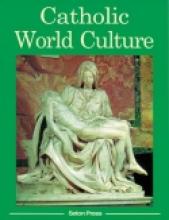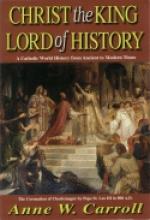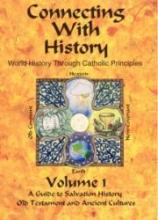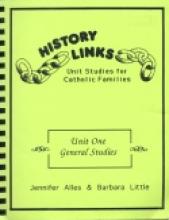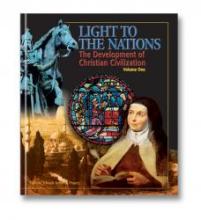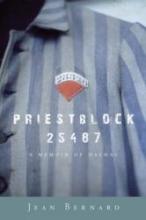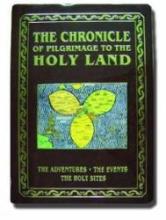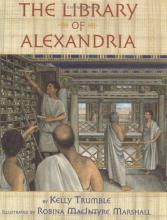Many books cover large periods of history, but I've yet to see one that includes so many personal experiences and fascinating stories in such a stunning, sweeping manner as does The Chronicle of Pilgrimage to the Holy Land. Most of us will never set foot in the Holy Land. Traveling there is a lot easier than it used to be, but, for me and most of the families I know, living our vocation takes up every spare minute—and most of our money. Nevertheless, we each have a strong and devotional attraction to the Holy Land. The Chronicle is an excellent means to feed that natural devotion we already have for the places where Jesus lived, worked and died. Pilgrimages have always been popular because man learns through his senses: though what we know by faith is unshakably true, it's reinforced by what we can see, touch and feel. This book, a virtual pilgrimage in itself, is a phenomenal help. When you read about what people went through in order to visit the Holy Land or what they sacrificed to keep Christian sites and artifacts from falling into Muslim hands, you can't help but feel awed and inspired.
The chosen format is that of a newspaper chronicling the history and legends of the Holy Land from the birth of Christ until the present. Unlike the newspapers of today, however, this one is wonderfully balanced, while also highly informative and detailed. While Christ is undoubtedly the focus, respectful consideration is shown to those others who consider this land holy for other reasons: the Jews and the Muslims. In the 2000 years covered there's not one snide insinuation, insulting jab, or indication of bias, which is highly unusual for anything historical, especially if it is also at all religious. Evil men and evil deeds are plainly told, just as good men and virtuous acts are faithfully recounted, and each with a level of detail that makes you feel as if you might have been there. I felt as if I met Christ again, living in the Body of Christ, but also in time. I met Him first walking the paths He walked, but then, too, in those who expressed their devotion, hope, or longing through their art or by embracing the physical hardship pilgrimage to the Holy Land entails. This narrative is not a marching through 2000 years of salvation history. It is an unfolding of God's plan in time, for individuals and peoples, in the language God uses to speak to us: Scripture first and foremost, but also, through people, events, and even things themselves. I would be so bold as to say that, through this book, I have felt God more closely, marveled at His providence and love throughout time more appreciatively, and wished to be a pilgrim myself. We each are, but I'm grateful for this more concrete connection with the broader family of God throughout time, and the places and things so holy to me as well.
This book begins with the birth of Christ and I can't think of a better way to prepare for Christmas. It does not stop there. We see Christianity thrive and grow as pilgrims from increasingly distant lands journey to the Holy Land to see for themselves the places where Jesus walked, preached, prayed, wept, suffered and died. Of course they wanted to see these places! I want to see them, too! This book has helped me get as close as I am likely to get in an amazingly personal and compelling manner.
The accompanying DVD/documentary helps enormously. I've watched quite a few documentaries. The first thing one immediately notices is the voice/manner of the narrator. Even terrific pictures/footage can be unjustly under-appreciated if the narration is terrible. This is still true if the narration is not half-bad. In this case, the footage is phenomenal, and the narrator is quite good: his manner is pleasant and manly, but not over-bearing. He walks you through the Holy Land, quietly guiding and informing you along the way, almost as if he doesn't want to intrude on your thoughts. The footage is breathtakingly beautiful. Some scenes are panoramic, and others up-close and personal. Though I've never been to the Holy Land, I now almost feel like I have. The DVD alone is a kind of pilgrimage.
The author treats religious matters, sites, and controversies with a reverent yet objective tone. As a teacher, I'm particularly appreciative of this because it's not only exhausting to constantly have to work against a writer's bias, it's sometimes so time-consuming it's unfeasible. This book, however, is a pleasure to read—a delight! It has none of that. It neither demonizes nor sanctifies the Crusaders nor vilifies the Muslims. It is very much what a history should be: presenting the facts in an engaging, living manner and backing them up with authentic documentation; in the words and art of the people who lived it. Everything—the photographs, the varied and beautiful artwork, and the citations from ancient documents—works together to give a well-rounded while also deeply personal account of what went on during various periods of time in the Holy Land. And there's a wealth of it!
In fact, this book could have been an art book with an emphasis on Christianity and a penchant for historical detail and documentation. The same balance I mentioned earlier is evident even in the selected artwork: there is such a variety of types and periods. What's most astonishing is the sheer number and quality of the images—aerial shots of Jerusalem and photographs taken inside the Basilica of the Annunciation interspersed with murals, paintings, and maps—give you a vivid impression of the Holy Land itself. The paper quality is excellent, and the book is over-sized (9X13), which is especially appropriate, pleasing and necessary because there are so many stunning photos, artworks, and additional documentation of astonishing variety throughout.
It certainly isn't the same as visiting in person but, together with the DVD that's included, it's the next best thing. I can linger over the images in the book, noting the inscriptions along the margins of the icons or carved into stone, while the DVD takes me through the streets of the major cities and sites at a visitor's pace. I can direct all my attention to the sights and sounds of Jerusalem while still having a guide to point out the things I wouldn't have noticed on my own. I also liked the way the author chose to convey historical events: as newspaper headlines with the stories in columns below. For example, in Chapter I, a headline reads: It's a Boy! followed by the sub-caption: "His Name is John." It's a clever way to retell a story that we've all heard many times: the birth of John the Baptist. And, later on in the same chapter, I read: "Joseph, Do Not Be Afraid” followed by: Angel Convinces Husband to Take Mary Home.
While I cannot show you the pictures or the artwork, I can give you a glimpse of the personal nature of the narrative throughout. This is an excerpt from William Lynch's travelogue (an American naval lieutenant exploring the Jordan and the Dead Sea in 1848): "Monday, April 17. At 9:30 p.m. we arrived at "El Meshra," the bathing place of the Christian pilgrims, after having been fifteen hours in the boats. This ford is consecrated by tradition as the place where the Israelites passed over with the Ark of the Covenant; and where our Blessed Savior was baptized by John. Feeling that it would be desecration to moor the boats at a place so sacred, we passed it, and with some difficulty found a landing below. My first act was to bathe in the consecrated stream, thanking God, first for the precious favour of being permitted to visit such a spot; and secondly, for His protecting care throughout our perilous passage. For a long time after, I sat upon the bank, my mind oppressed with awe, as I mused upon the great and wondrous events which had here occurred. Perhaps directly before me, for this is near Jericho, "the waters stood and rose up upon a heap," and the multitudinous host of the Israelites passed over. ...Tradition, sustained by the geographical features of the country, makes this also the scene of the baptism of the Redeemer. The mind of man, trammeled by sin, cannot soar in contemplation of so sublime an event. On that wondrous day, when the Deity veiled in flesh descended the bank, all nature, hushed in awe, looked on, —and the impetuous river, in grateful homage, must have stayed its course, and gently laved the body of its Lord." (p. 198)
Christ promised not to leave us orphans, and He did so through His Church and the sacraments. Man learns through his senses, so concrete signs of God's presence among us is both necessary and comforting. And yet, even the sacraments are in some ways not that concrete. Baptismal water is not (for most of us) the Jordan. Mass is not Holy Thursday, though it definitely began there. This is at least partly why so many from such faraway places and varied circumstances for over two thousand years have felt blessed to make the journey to the Holy Land; to be a pilgrim walking where Christ walked, seeing what Christ saw, in a spirit of prayer and penitence, faith and hope. It is a witness to the Body of Christ over time and throughout the earth. We have countless brothers and sisters, each taking this journey in some way. Some belong to the Church Triumphant (St. Helen of the Cross and St. Louis IX, for example), some to the Church Suffering (and we don't know who they are for sure, but history may lead us to suspect and we should definitely pray for them), and some to the Church Militant, who have always and do still fight for Christ as best they can and as demanded by the circumstances of their lives. We, who follow the tales of these pilgrims can relate, learn, and benefit, today as yesterday.
Lastly, another remarkable aspect of The Chronicle is its scope. From the events surrounding the life of Christ (Chapter I) up through "Twentieth-Century Pilgrimage" (Chapter XI: 1917 onward), this book explains the political forces behind the wars, the various difficulties faced by both pilgrims and Crusaders, and the internal struggles among the Muslim caliphs that accounted for bursts of benevolent tolerance as well as sudden and harsh reprisals almost completely through personal accounts. I will try to give you some sense of that by giving you a peek at each of the 11 chapters. Seriously, it's just a peek. You would not believe all that I had to leave out! Each chapter begins with a synopsis of the period covered, which is then fleshed out through the pilgrims and events of the day.
Chapter I: The Footsteps of Jesus
This chronicles the life of Christ and lays the foundation for all the chapters to follow: this land is holy because Christ was born, lived and died here.
Chapter II: The Byzantine Period (324-634 CE)
Once Christianity became the official religion of the Roman Empire (4th century), pilgrimages to Jerusalem increased. The difficulties involved and the hardships to be endured were extreme. First, there was the sea voyage. Ships were built for function rather than comfort and pilgrims would be crowded together in the hold, living on food that rotted a little more each day. Assuming that they survived the voyage, there were wars to avoid, governments that would spring up and collapse whenever one took his eyes off of them, and the only rule that was stable was inimical to Christians. St. Helen of the Cross, churches built, wars between various non-Christians, Jerusalem changes hands frequently. Monasticism in the Holy Land: hermits and communities Mosaics, sections of carpet/floor, baptismal founts, St. Sabbas in his coffin (skeleton in fine garb)
Chapter III: The Early Arab Period (634-1099)
Various caliphs, their internal wrangling, the ones held in high regard and the traitorous dogs. Earthquake destroys Bethlehem but leaves Church of Nativity untouched. Church encourages sinners to make pilgrimages for sins.
Chapter IV: The Kingdom of Jerusalem (1099-1187)
Pope calls for knights to stop feuding and save Holy Sepulcher. Peter the Hermit’s disastrous People’s Crusade. “Tancred of Apulia Conquers Galilee with 80 Knights.” Godfrey’s (Protector of the Holy Sepulcher) sword, spurs, and cross photo. Teutonic Order of Knights in response to German/French hostility (German inscription on knight’s tomb erased and French one substituted). Love triangle
between Eleanor of Aquitaine, Louis VII, and Raymond of Antioch (ended in divorce). Crusaders rebuild Church of Holy Sepulcher. Women in the Crusades. Saladin defeats the Crusaders and razes all their fortress but neglects city of Tyre, thereby leaving possibility of a third crusade.
Chapter V: The Second Crusader Kingdom (1187-1270)
Heavy hitters set out to face Saladin and retake Jerusalem: Richard Lionheart, Philip II, Friedrich Barbarossa. Almost 3000 Muslim prisoners executed at Acre when Saladin refuses terms. Saladin nearly takes Jaffa but Richard Lionheart’s timely arrival and daring dive into the surf saves Christian defenders. St. King Louis’s role and death.
Chapter VI: The Mameluke Conquest (1260-1516)
Non-Christians crack down on pilgrims—Franciscans charged fee and threatened with beating to death—and destroy Church of Annunciation. Non-Christians make money off pilgrims. Pilgrims complain of noise, unpleasant odors, living conditions, and fees associated with food/travel/amenities. Prestige knighthood titles. Bogislav wrote a third-person account of his own exploits against the Turkish pirates and fought off the last of them with a skewer for roasting chickens.
Chapter VII: Under Ottoman Rule (1516-1798)
Turks drug their soldiers and camels with opium (for fighting spirit). French pharmacist mentions 275 plants from his journey to Holy Land by name. Scotsman William Lithgow writes crude, simple account of his travels, using nicknames where he forgot the real ones, and bluntly informing critics of his work that he wished they would hang. Bestseller in twelve editions and sold for 200 years. Dutch De Bruyn paints the Holy Land.
Chapter VIII: Into the Nineteenth Century (1798-1831)
Napoleon attempted to take the Holy Land but turned back at Acre. The Princess of Wales was royally treated by Suleiman despite suspected scandalous behavior. William John Banks, a member of the British House of Commons, carried out the first archeological excavations in Jerusalem. In renovating the Church of the Holy Sepulcher, the Greek Orthodox nearly went bankrupt. Irishman Richard Madden outwits bandits four times, with the last time being the most impressive. While never lucky, the Irish are, indeed, plucky.
Chapter IX: The Advent of the Modern Age (1831-1876)
Artists, architects, scientists and unlikely physicians from various countries all use their gifts to better appreciate and understand the Holy Land and its people. Jerusalem is photographed for the first time. The British conquer Acre, which must have been especially gratifying as Napoleon couldn't.
Chapter X: The Sunset of the Ottoman Empire (1876-1917).
Ottoman Turks ally with the Germans, sundering ties with the British, and fall with them when they're defeated in WWI. Kaiser Wilhelm journeys east, "feeling himself a modern Crusader, though the preparations for his journey were made by the English travel agency Thomas Cook and Sons, Ltd." The Kaiser was thus referred to as "Cook's Pilgrim". At least he got a capitol "P". Lawrence of Arabia surveys Byzantium...but in which sense? Both, maybe? The Holy City surrenders to the British. Thank God.
Chapter XI: Twentieth-Century Pilgrimage (1917 onward)
Pope Paul VI visits the Holy Land...the first pope to do so. In the Jubilee year 2000, JPII also made a pilgrimage: "To come here and to pray in the most important places which, from ancient times, have seen God's interventions, the wonders He has done."

